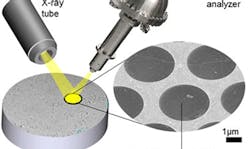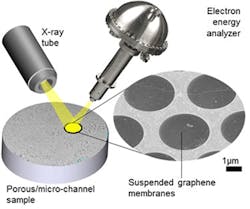X-Ray Photoelectron Spectroscopy Made Simple with a Graphene Barrier
Researchers from the National Institute of Standards and Technology (NIST), ELETTRA (Italy), and Technical University of Munich have designed a protective graphene membrane that will allow X-ray photoelectron spectroscopy (XPS) at ambient pressures.
XPS is a useful tool for studying small-scale surface properties, reactions, and interactions. However, the need for a vacuum environment in XPS poses a problem when testing samples that require pressurized gaseous or liquid environments. Scientists therefore have designed a graphene barrier to be placed on the sample surface for protection from the vacuum. Graphene, a single-layered material made of carbon atoms, does not hinder the passing of X-rays or photoelectrons and can maintain a pressure gradient between the vacuum and high-pressure sample. Implementing a graphene barrier is less expensive and less complicated than other methods for accommodating pressure-sensitive testing conditions.
The first step of XPS involves bombarding a sample surface with X-rays of the same energies. X-rays must pass through a vacuum, in the absence of any interfering medium, to avoid unaccounted deflection of the rays before they reach the sample. The X-rays are absorbed by the atoms on the sample surface, which consequently emit photoelectrons at characteristic binding energies. The binding energies are then analyzed by the XPS detector to determine the chemical state and make-up at the sample surface. The photoelectrons also must travel to the XPS detector through a vacuum, to avoid distortions by a medium that would falsify the readings.
Researchers in the study aimed to create a simple, inexpensive, and convenient method to protect samples that require a gaseous or liquid environment at 1 atmosphere. Due to graphene’s impermeability to any gas or liquid and its resilience to the specified pressure, the barrier was effective for protecting the sample from the surrounding vacuum and maintaining the pressure gradient. Graphene’s transparency to X-rays and photoelectrons successfully prevented alteration of the spectroscopy results. The study still has room for growth, as the membrane showed a weakness in adhesion to the sample surface and X-rays tended to weaken the graphene after several trials.
The report is published in the journal Nanoscale.
About the Author
Leah Scully
Associate Content Producer
Leah Scully is a graduate of The College of New Jersey. She has a BS degree in Biomedical Engineering with a mechanical specialization. Leah is responsible for Machine Design’s news items that cover industry trends, research, and applied science and engineering, along with product galleries. Visit her on Facebook, or view her profile on LinkedIn.

